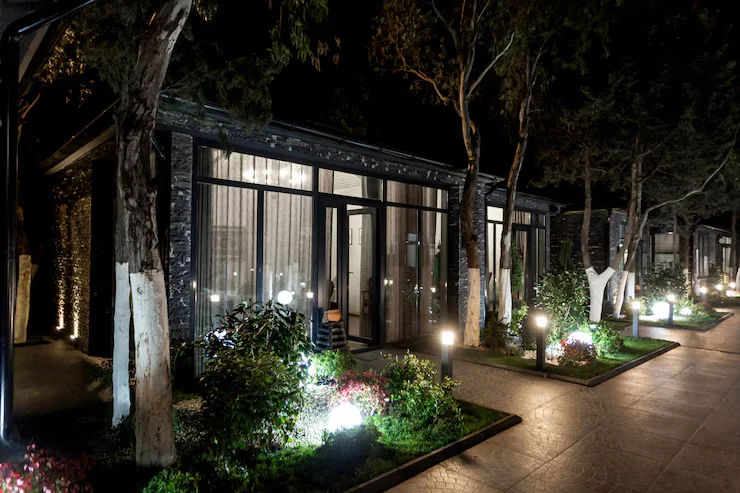Outdoor spaces can transform into enchanting realms when dusk falls, provided they have the right illumination. Mastering the art of outdoor lighting can enhance the beauty of your garden, improve security, and extend the evening hours in your personal oasis. In this comprehensive guide, we’ll explore the advantages of using 12v garden lights to create a captivating nocturnal landscape.
Understanding 12V Garden Lights
12V garden lights are a popular and versatile option for outdoor illumination. This low-voltage lighting is safer to install and is more energy-efficient compared to traditional 240V systems. By utilising a transformer, these lights reduce the mains voltage down to a safer 12V, making them a practical choice for the outdoor environment where moisture and wear pose a risk for electrical systems.
Another appealing trait of 12V garden lighting is its variety. They come in numerous designs, including spotlights, path lights, deck lights, and feature lighting, allowing homeowners to customise their outdoor setup to their precise needs.
The Benefits of 12V Garden Lighting
When you select 12v garden lights, you are not only choosing a safe option, but you are also opting for sustainability and cost-effectiveness. Low-voltage lights consume less power, making them an environmentally conscious selection that can also lead to reduced electrical bills.
The installation process is relatively straightforward and can often be accomplished without professional help. This DIY-friendly approach means that you can design and modify your garden lighting scheme as your landscape grows and changes.
Designing with Light
The first step in enhancing your garden’s night-time appeal is to design your lighting layout. Consider the key features you wish to highlight, such as statues, water features, or particular plants. Also, think about the areas that require functional lighting for safety, like walkways and step edges.
Choosing the correct type of light for each area will amplify the effect. For instance, spotlights can draw attention to architectural features, while softer path lights can provide a gentle glow that outlines your garden’s layout.
Creative Positioning
Once you have decided which features to accentuate, consider the positioning of your lights. The angle and distance of 12V garden lights can significantly alter the mood and ambiance you’re aiming for. Up-lighting trees or sculptures can create dramatic silhouettes, whereas down-lighting can emulate the soft touch of moonlight filtering through branches.
A balance between function and aesthetics is crucial. Ensure that the areas where you move about have adequate lighting to navigate safely, while the more decorative elements of your garden can be illuminated with a creative touch.
Layering Your Landscape Lighting
A masterful lighting design incorporates layering. By using a variety of light intensities and placements, you can create a three-dimensional experience in your garden. Path lights can serve as a foundational layer, providing a base level of illumination, while accent lights can add depth and texture. Feature lighting then acts as the final touch, spotlighting the most captivating elements of your outdoor space.
Maintaining Your 12V Garden Lights
Maintenance is essential to ensure your 12V garden lights continue to function correctly and safely. Regular cleaning of light fixtures and replacing burnt-out bulbs is needed to maintain illumination quality. Also, periodically checking cables and connections for wear and tear will prevent potential hazards and prolong the life span of your outdoor lighting.
Choosing Weather-Resistant Fixtures
Since garden lights are exposed to the elements, selecting weather-resistant fixtures is crucial for longevity. Look for lights made from durable materials such as stainless steel or aluminium that are designed to resist corrosion and water ingress.
The Final Touch: Automation and Control
Incorporating timers or smart control systems for your garden lighting can add a layer of convenience and security. Automating your lights to turn on at dusk and off at dawn ensures your garden is well-lit when needed and conserves energy when it’s not.
Light sensors can also adjust the brightness of your lights based on natural light levels, providing the perfect amount of illumination at any time. Remote control systems allow you to modify your lighting from the comfort of your home, changing the atmosphere to suit any occasion.
Conclusion
Effective outdoor lighting creates an ambiance that can transform your garden into a picturesque setting for relaxation and entertainment. By utilising 12v garden lights, you can achieve this while being mindful of safety, energy consumption, and maintenance needs.
Implementing a thoughtful design, considering the positioning and layering of lights, and selecting durable fixtures are key steps to mastering outdoor illumination. With these considerations in mind, you can brighten your nights and make the most out of your outdoor living spaces for years to come.







